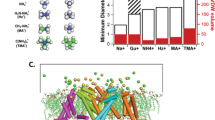Abstract.
The outer sulcus epithelium was recently shown to absorb cations from the lumen of the gerbil cochlea. Patch clamp recordings of excised apical membrane were made to investigate ion channels that participate in this reabsorptive flux. Three types of channel were observed: (i) a nonselective cation (NSC) channel, (ii) a BK (large conductance, maxi K or K Ca ) channel and (iii) a small K+ channel which could not be fully characterized. The NSC channel found in excised insideout patch recordings displayed a linear current-voltage (I-V) relationship (27 pS) and was equally conductive for Na+ and K+, but not permeable to Cl− or N-methyl-d-glucamine. Channel activity required the presence of Ca2+ at the cytosolic face, but was detected at Ca2+ concentrations as low as 10−7 m (open probability (P o ) = 0.11 ± 0.03, n= 8). Gadolinium decreased P o of the NSC channel from both the external and cytosolic side (IC50∼ 0.6 μm). NSC currents were decreased by amiloride (10 μm− 1 mm) and flufenamic acid (0.1 mm). The BK channel was also frequently (38%) observed in excised patches. In symmetrical 150 mm KCl conditions, the I-V relationship was linear with a conductance of 268 pS. The Goldman-Hodgkin-Katz equation for current carried solely by K+ could be fitted to the I-V relationship in asymmetrical K+ and Na+ solutions. The channel was impermeable to Cl− and N-methyl-d-glucamine. P o of the BK channel increased with depolarization of the membrane potential and with increasing cytosolic Ca2+. TEA (20 mm), charybdotoxin (100 nm) and Ba2+ (1 mm) but not amiloride (1 mm) reduced P o from the extracellular side. In contrast, external flufenamic acid (100 μm) increased P o and this effect was inhibited by charybdotoxin (100 nm). Flufenamic acid inhibited the inward short-circuit current measured by the vibrating probe and caused a transient outward current. We conclude that the NSC channel is Ca2+ activated, voltage-insensitive and involved in both constitutive K+ and Na+ reabsorption from endolymph while the BK channel might participate in the K+ pathway under stimulated conditions that produce an elevated intracellular Ca2+ or depolarized membrane potential.
Similar content being viewed by others
Author information
Authors and Affiliations
Additional information
Received: 14 October 1999/Revised: 10 December 1999
Rights and permissions
About this article
Cite this article
Chiba, T., Marcus, D. Nonselective Cation and BK Channels in Apical Membrane of Outer Sulcus Epithelial Cells. J. Membrane Biol. 174, 167–179 (2000). https://doi.org/10.1007/s002320001041
Issue Date:
DOI: https://doi.org/10.1007/s002320001041



